
ABDNHA home | Wildflowers | Current Report
Wildflowers: Winter in Anza-Borrego

Hornblende Canyon
11 March 2012 – It was impossible to walk into Hornblende Canyon, looking for flowers this morning, and not notice the geology. One assumes this narrow canyon was once a creekbed. Layers of sandstone, uplifted and twisted by millions of years of earthquakes, are the remarkable remains. The greatness of Anza-Borrego is that it is more than just one part like botany or geology or bumpy jeep trails. It is the sum of all its parts that make it so important to us.
Most of what little flower activity there is in the parks (the state park, the county parks) right now seems to be in canyons and washes at elevations of two to three thousand feet. There have been good sightings at Palm Canyon west of Borrego Springs, Mine Wash and Plum Canyon off of Highway 78, Hornblende Canyon, the California Riding & Hiking Trail, canyons of Agua Caliente County Park, and the canyon west of mile marker 41 off of Highway S-2.
The Ephedra is covered with tiny golden flowers. Yellow flowers are appearing on the tops of the Barrel Cactus. The Cheesebush flowers may go unnoticed because of their small size and unspectacular color but, when the flowers pop into fruit, the Cheesebush gets attention.
For us, color and fragrance were the first things that attracted us to flowers. After all these years, we still admire a flower's color and fragrance. We are also happy on a day when we find a plant we've never seen or seldom see, or are seeing for the first time on a particular year. In this category on this day, it was a Few-Flower Wreath Plant in Hornblende Canyon and a Woolly Sunflower on a nearby stretch of the California Riding and Hiking Trail.
Details and photos. Ephedra. Barrel Cactus. Cheesebush. Few-Flower Wreath Plant. For a description of, and directions to, Hornblende Canyon, see Robin Halford's Hiking in Anza-Borrego Desert: Over 100 Half-Day Hikes, available at ABDNHA's Borrego Desert Nature Center.
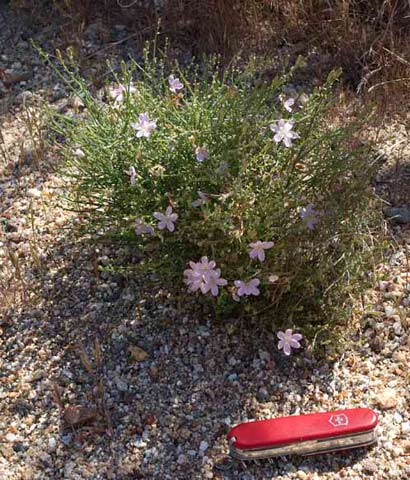
Few-Flower Wreath Plant,
Stephanomeria pauciflora var. pauciflora
Asteraceae
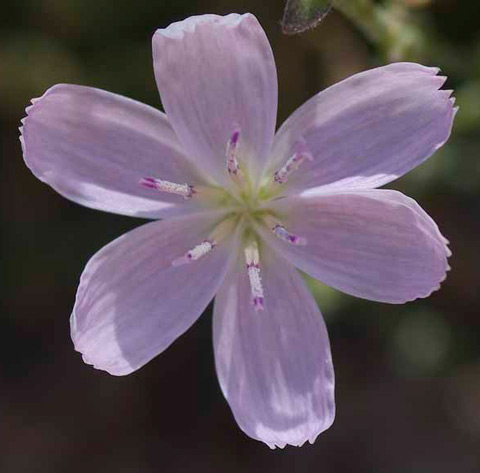
Few-Flower Wreath Plant,
Stephanomeria pauciflora var. pauciflora
Asteraceae
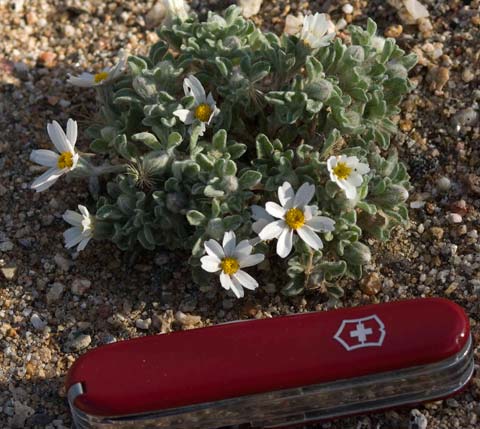
Woolly Sunflower, Eriophyllum
Asteraceae
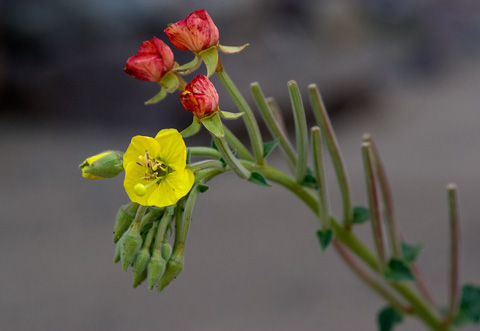
Heart-leaved Evening Primrose, Camissonia cardiophylla
Onagraceae
29 February 2012 – Desert Dandelions and Arizona Lupines can be found beside County Road S-2 from south of Agua Caliente County Park to Canyon sin Nombre. The numbers are not great, and the sizes may be small, but they are a presence to be enjoyed.
A brief stop at Fossil Canyon in the Coyote Mountains outside of Ocotillo produced a good list of species from a walk up the road and in and out of a few tributary canyons. Species seen included Heart-leaved Evening Primrose, Desert Tobacco, and a few Ghost Flowers in the rocky wash. There was lots of Cryptantha on the ground, and some nice patches of Pygmy Golden Poppy. Desert Bird-of-Paradise, a signature shrub of this canyon, was out in its usual force, although looking dry. Peirson's Brown-Eyed Primose, which usually covers the entire Ocotillo area, was only seldom seen. Desert Holly, a saltbush that thrives where soil is salty, was seen in soft green fruit, one of the great spectacles of this flower season.
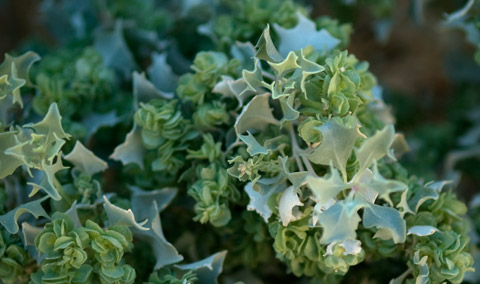
Desert Holly, Atriplex hymenelytra
Amaranthaceae
Others flowering or fruiting plants noted were Desert Sunflower, Desert Pincushion, Burrobush, Desert Trumpet, Cheesebush, Desert Lantern (another member of the wonderful Evening Primrose family, Onagraceae), Sweetbush, Creosote, Brittlebush, Parish's Golden Eyes, Spanish Needles, Arizona Lupine, Desert Lavender, and the belly flower Desert Star.
Meanwhile, Tom Chester reports on a trip along County Road S-2 which included stops at Blair Valley, Smuggler Canyon Wash, and the canyon west of Mile Marker 41: "Kate Harper, Vince Balch and I found over 2,720 plants of 88 species in bloom below 3000 feet." Annuals seen in good numbers include Bigelow's Monkey Flower, Ghost flower, Dwarf Golden Poppy, and Desert Dandelion.
On a stroll along the California Riding and Hiking Trail, from Box Canyon to the Oriflamme Canyon Road, we were pleased to note 20 small Thistle Sage plants in flower.
Details and photos. Desert Dandelion, Arizona Lupine, Heart-leaved Evening Primrose, Desert Tobacco, Ghost Flower, Cryptantha, Pygmy Golden Poppy, Desert Bird-of-Paradise, Peirson's Brown-Eyed Primrose, Desert Sunflower, Desert Pincushion, Burrobush, Desert Trumpet, Cheesebush, Desert Lantern, Sweetbush, Creosote, Brittlebush, Parish's Golden Eyes, Spanish Needles, Desert Lavender, Desert Star, Bigelow's Monkey Flower, Thistle Sage.
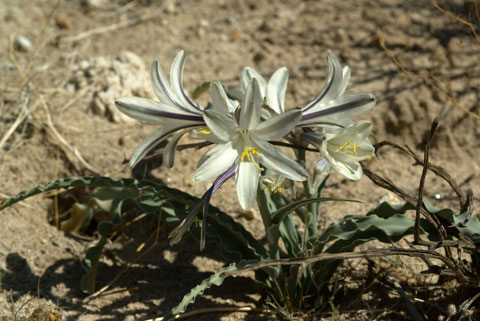
Desert Lily, Hesperocallis undulata
Agavaceae
21 February 2012 – A walk into Canyon sin Nombre, covering no more than a mile from the Sweeney Pass Road (County Road S-2), had remarkable results. We saw in flower some 40-50 Barrel Cacti, six to eight Desert Lilies, and one clump of Beavertail Cactus. A number of Desert Lilies and Beavertail were in bud. These plants were not visible from the jeep road. We hiked off the jeep road cross country toward the north end of the long ridge that faces those who start down the jeep trail from S-2. From there, we made our way in a southerly direction along the base of the ridge.
NOTE: The Canyon sin Nombre jeep road, and the roads beyond, are for high-clearance 4WD vehicles. The safest way to enter this area is on foot. Park off the pavement along S-2 and walk.
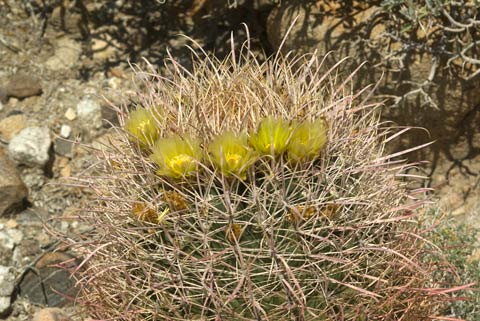
Barrel Cactus, Ferocactus Cylindraceus
Cactaceae
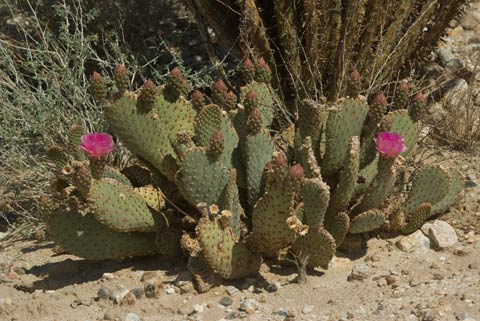
Beavertail Cactus, Opuntia basilaris
Cactaceae
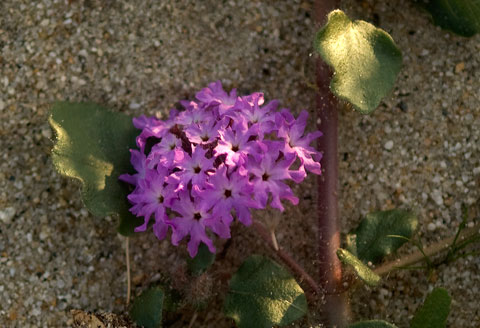
Desert Sand-Verbena, Abronia villosa
22 December 2011
18 February 2012– Last December, when we noticed a Desert Sand-Verbena growing in the sand near Coyote Creek, little did we realize it might be the last plant of that species we would see in this locality all season. But sure enough, that is how things have worked out in this strange year. On a walk from Desert Gardens to the creek's First Crossing, we found only three Desert Dandelions, two Desert Pincushions, and one Arizona Lupine. Plants with the most flowers and buds were Cheesebush and California Croton. Luckily, there was water and plenty of greenery in Coyote Creek. Emory Rock-Daisy and Spanish Needles were abundant in the creek bed, and we noticed just one Brown-Eyed Evening Primrose. Full Report.
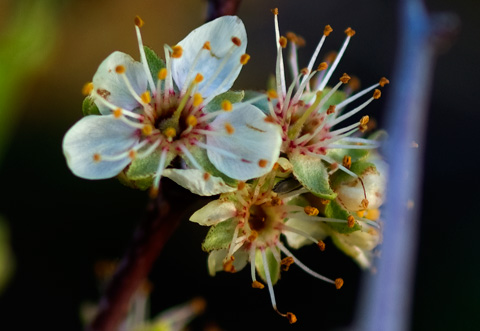
Desert Apricot, Plum Canyon
17 February 2010 – Today's visit to Plum Canyon reminded us that even in a year when flowers are few, there still is much to see and admire in the plant world. Cholla, mostly Gander's Cholla and Teddy-Bear Cholla, is everywhere beside the Plum Canyon trail, and it's especially remarkable at hours when the light shines behind it, illuminating its spines. Remarkable too are the canyon's north-facing granite boulders which are home to moss and colorful lichen. And of course there are the shrubs that always seem to find what they need to flower, from the brilliant red flowering Chuparosa to the quiet blue-flowering Desert Lavender. Full report.
15 February 2012 – Amid all the desert dryness, it's possible to find flowers in bloom. Your patience and persistance, if you can muster them, will be rewarded, as ABDNHA member Michael Charters shows us.
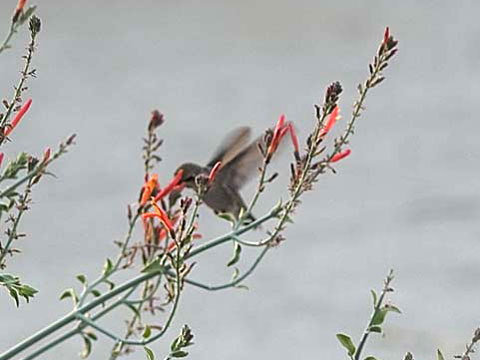
Chuparosa, Justicia californica
Amaranthaceae
13 February 2012 – According to the calendar, we are now in the second half of winter. By desert reckoning, this usually means the annual spring wildflowers are blooming nicely. But this is a different year. It has been a dry year, and those wildflowers need rain. We haven't had the rain. There are annuals to be seen in some places, especially in the southern desert areas, but their size and numbers are diminished. The larger perennials are another story. It's possible to find Chuparosa, Desert Lavender, and Brittlebush with flowers now.
Visitors may find that for the best viewing they may have to get out and walk a bit. Luckily, roadsides are some of the best spots. Getting down on hands and knees may be necessary. A magnifying glass may be useful.
For knowledgeable botanists, it's a different outlook. Tom Chester, who has spent the last few weeks looking at plants in and around Mason Valley, reports having seen 50 annual species, and 152 species total, in bloom so far this year. This, he says, essentially matches the 2010-2011 numbers as of this date. Only about 50 species are left to come into bloom; approximately three-fourths of our desert annuals are in bloom somewhere in the park.

Fossil Canyon
22 January 2012 - Tom Chester sends this report after a drive down S-2 to Fossil Canyon. The canyon is in the Coyote Mountains, and often is a good place to find wildflowers in bloom before they appear further north. It is reached by turning east at the stop sign at Shell Canyon Road on the north edge of Ocotillo.
Blair Valley - Good germination by the parking area next to S2, but it is essentially all non-native Filaree or Storksbill, accompanied by a smaller number of native Pectocarya and Popcorn Flower. The Filaree and Pectocarya were beginning to bloom.
Mason Valley. Good germination of a number of native annuals, as well as non-native Filaree or Storksbill and Sahara Mustard, both of which were blooming. Most of the Sahara Mustard was very small pathetic-looking plants with just a few flowers, which is all they will have total unless they get more rain, and maybe even if they do.The Popcorn Flower was beginning to bloom there as well.
Mason Valley to Carrizo Badlands Overlook. There seemed to be fairly uniform decent germination whenever we looked at the roadside and beyond, but we didn't stop, so don't know what it was composed of. At the Carrizo Badlands Overlook, no germination except under some shrubs, and in a little drainage. the germination there was pretty sparse, but way better the none, of mostly native plants: Phacelia distans, Erodium texanum, and even Desert Five-spot.
Fossil Canyon. EXCELLENT germination there, entirely of NATIVE annuals!!!! We saw no Sahara Mustard, Storksbill, or other non-native annuals. What a pristine area plant-wise!
Non-plant wise it is not quite so pristine, due to shotgun shells; shooting
noises; car and motorcycle tracks; broken glass; old cans; etc., in a small
number of areas.
If we get more rain, this canyon will look good. we saw:
- Zillions of baby Pygmy Gold Poppy and Parish's Gold Poppy
- Hillsides colored green with zillions of baby White Pincusion (Chaenactis carphoclinia)
- Zillions of baby plants, probably Phacelia minutiflora
- Lots of Blazing Star (Mentzelia involucrata or Mentzelia hirsutissima), and Emory's Rock-Daisy
- A good number of Desert Chicory
- A Desert Mistletoe in flower
There were plenty of other baby annual species as well. These annuals all looked like they had germinated fairly recently, perhaps from the December rain. Some had only just grown their first true leaves. Furthermore, the shrubs all looked pretty good. Brittlebush had lots of its big green rainfall leaves, and the Caesalpinia virgata was just leafing out.
If they don't get any more rain, the annuals will all flower pathetically. But if we get rain in the next month, it will be a good year there.
Details and Photos. Storksbill, Sahara Mustard, Phacelia distans, Desert Five-spot, Pygmy Gold Poppy, Gold Poppy, Blazing Star, Emory's Rock-Daisy, Desert Chicory, Desert Mistletoe, Brittlebush, Caesalpinia virgata.
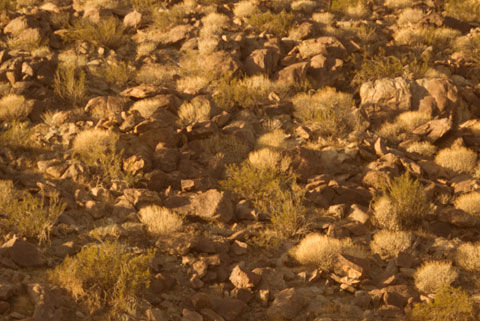
Plant Life, Desert Hillside, Chilly Winter Morning
22 December 2011 - Winter is here. The flowers are hibernating. Some of the shrubs are freshly green, thanks to recent rains, while other shrubs remain faded by the summer sun. Cheesebush is one shrub in a lovely time of its life, partly gold because of the sun, and partly green because of the rain.
Desert Holly, a species of saltbush, is displaying tiny red buds where it it found, in salty soils in the badlands. The yellow flowers of Boundary Bush, a holdover from the fall, remain in Canyon sin Nombre, while Black-stem Rabbitbrush, another holdover, can be seen in Pinyon Wash and Coyote Canyon. Desert Dicoria, with greenish-white fruit and greenish flowers, is a common sight in the Borrego Valley. Datura is also commonly seen.
A walk on the Coyote Canyon Jeep Trail, from Desert Gardens to Second Crossing, finds flowers on Rush Milkweed at Ocotillo Flat, and several Spanish Needles, a lone Sand Verbena, and a tall Desert Agave. Mule-fat is providing seeds and cover for the many bird species around Second Crossing, and a few yards past the gaging station are a few remarkably large stands of Bladderpod with green fruit and yellow flowers.
The only sad thing to report is Sahara Mustard, its tiny leaves sprouting in various spots beside the jeep trail. Fortunately, it isn't everywhere. That's the good news.
The other good news: By the end of winter (on the calendar), there will be annual wildflowers in bloom in Anza-Borrego.
Details and photos: Cheesebush, Desert Holly, Boundary Bush, Black-stem Rabbitbrush, Desert Dicoria, Datura, Rush Milkweed, Spanish Needles, Sand Verbena, Desert Agave, Mule-Fat, Bladderpod, and Sahara Mustard.
Anza-Borrego Desert Natural History Association
P O BOX 310 ( 652 Palm Canyon Drive) Borrego Springs, CA 92004-0310
Office 760-767-3052 | Desert Store & Nature Center 760-767-3098 | FAX 760-767-3099